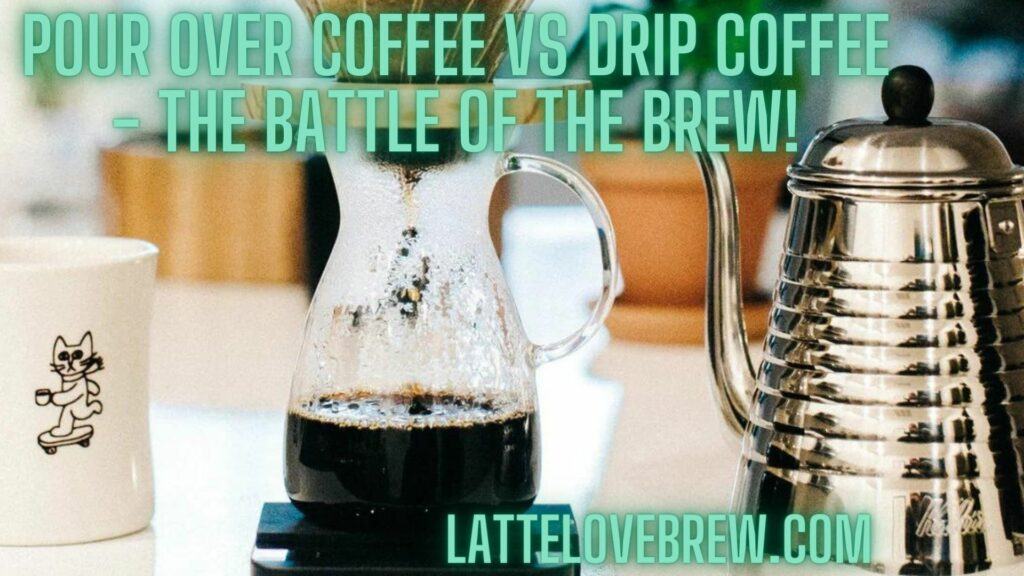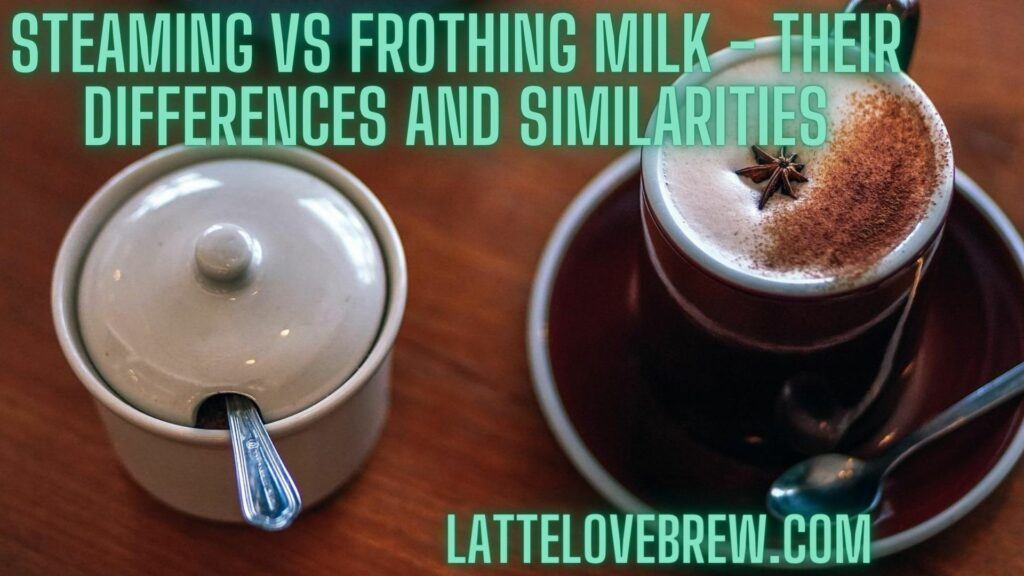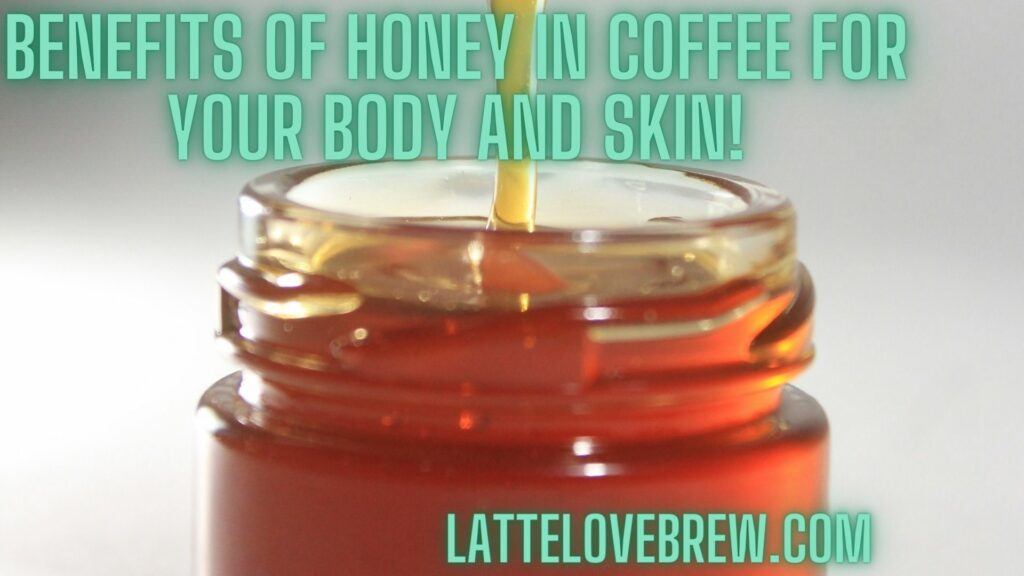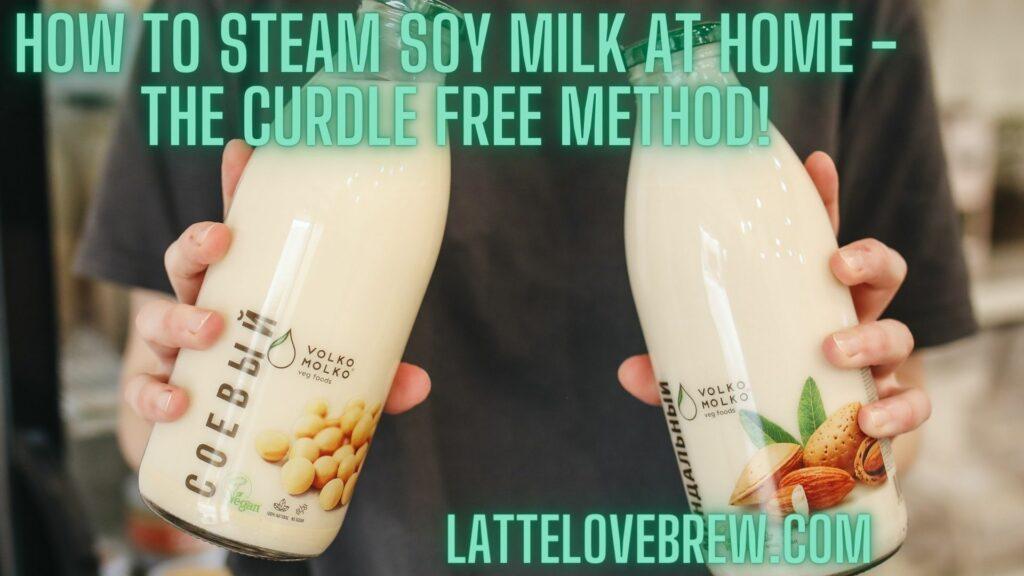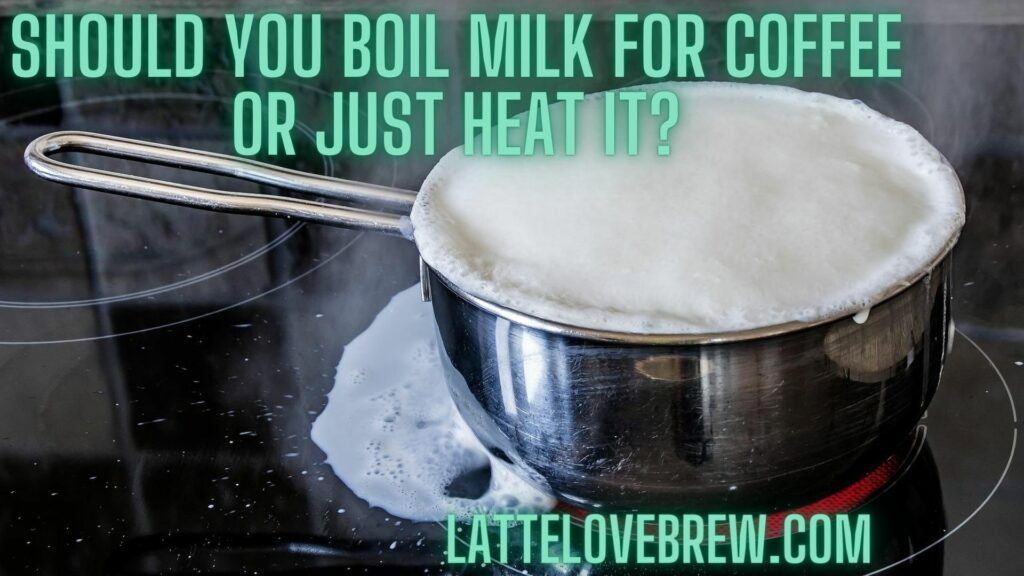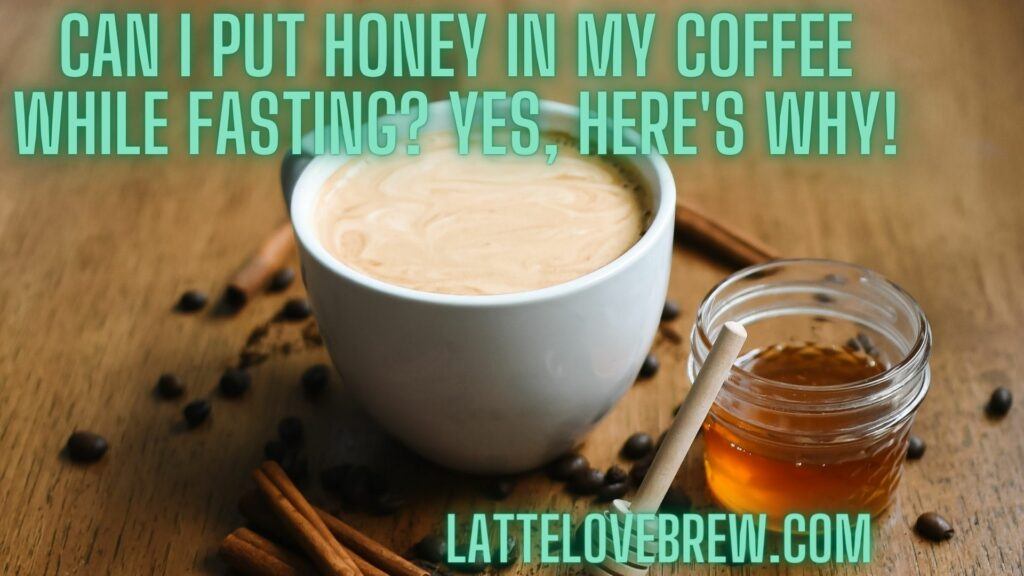Last updated on November 13th, 2023 at 14:15
In this battle of the brew it’s pour coffee vs drip coffee! And boy, I have something cooked up and well brewed up for you here!
This is the most detailed article and guide to both of the brewing methods and techniques that you will find anywhere – period.
While it is not my prerogative or style to outright tell you directly if pour over or drip coffee is best as everyone is different and everyone likes different types of coffee. I do, where and when appropriate, tell you which is better and why.
Keep reading for a great guide to two great brewing techniques and an honest comparison.
Pour Over Vs Drip Coffee: What Is Difference Between Drip And Pour-Over Coffee Maker?
Table Of Contents
- 1 Pour Over Vs Drip Coffee: What Is Difference Between Drip And Pour-Over Coffee Maker?
- 2 Pour Over Coffee Vs Drip Coffee – The Brewing Methods
- 3 Pour Over Coffee Vs Drip Coffee – The Final Drink Quality
- 4 Amount Of Control Over The Brewing Process – Drip Coffee Vs Pour Over!
- 5 Pour Over Coffee Vs Drip Coffee: Brew Time
- 6 Pour Over Coffee Ratio Vs Drip Coffee Ratio
- 7 Drip Vs Pour Over Grind Size
- 8 The Ideal Roast Profile
- 9 The Taste Challenge
- 10 Benefits Of Pour Over Coffee
- 11 Benefits Of Drip Coffee
- 12 Frequently Asked Questions About Pour Over Coffee Vs Drip Coffee
- 13 Is Pour-Over Coffee Better Than Drip?
- 14 Final Thoughts – Pour Over Coffee Vs Drip Coffee
A drip coffee machine is quick and easy to use, and effortlessly you can make a cup of coffee that tastes great and get the same cup every single time.
The pour over coffee brewing, which is fairly similar to the drip method of coffee brewing in the sense that you saturate the coffee grounds with hot water and then filters the coffee as it passes down through the coffee filter and into the cup or carafe below.
The one stand out difference and problem with the drip coffee method is that the barista has little to no control over how the drip coffee machine brews the coffee.
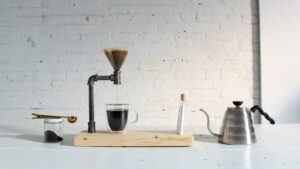
Read: Difference between drip coffee and pour over
Pour Over Coffee Vs Drip Coffee – The Brewing Methods
What Is Pour-Over Coffee
Pour over coffee is a similar brewing method to an automatic drip coffee maker and the drip brewing method in the sense that they both depend on the use of hot water to saturate the coffee grounds, which then pass through a coffee filter.
The biggest difference is the lack of control with an automatic drip coffee maker. You get to select the grind size, and type of filter used. Nothing else. The rest is automated.
The pour-over method of coffee brewing gives you full control of all the variables that affect the outcome of the final brew, including the temperature, pour rate and brew time, which results in you having full control over the texture, taste and strength of the final cup of coffee.
There are a lot of different devices and equipment that you can use for pour-over coffee; it doesn’t matter which one you use as the techniques are the same.
One of the best and most useful pieces of equipment for making a great pour over coffee is a digital temperature-controlled gooseneck kettle.
This type of kettle allows you to have precision control over the temperature and the flow of water.
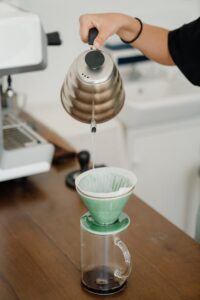
Read: Drip coffee
How To Make A Pour Over Coffee – The Brewing Technique
The best coffee beans will produce the best tasting cup of coffee. When you are making coffee, I encourage you to use specialty grade coffee beans.
It is best that you use medium to dark roast coffee beans for this brewing method due to the short brewing time.
Start by weighing your coffee beans and weight them as whole as you will keep them fresher for a little longer, and the mass is the same be they ground or whole.
The ideal coffee to water ratio is 1:15, for the pour-over method for clarity, this s one part coffee and 15 parts water. For a good-sized 12 ounce (360 ml) cup you will need 0.8 Oz (25 grams) of coffee and 12 (360 ml) oz of water.
Water has a density of 1 gram = 1 ml and is easy to calculate; however I still encourage you, for sake of accuracy, to weigh your water.
Heat your water to the perfect water temperature of 96C (205F), which can be controlled digitally with a digital gooseneck kettle.
While your water is heating up, you can get your coffee beans ready and grind them to a good, even medium to coarse grind size. A ceramic burr grinder is better due to achieving an even grind quality and less heat transfer from the friction to “cook” your grinds.
Put your grinds into a filter of your choice. Each type of filter will produce different results. A paper filter will produce a clean, crisp taste with a lighter body. A metal filter will produce a full-bodied coffee that is full flavored.
A cotton cloth will produce a result that is in between a metal filter and a paper filter.
Add your grounds to your filter. Give it a shake while on a flat surface to ensure an even distribution of the grounds. Pour enough water, slowly and evenly in a spiral motion, to wet your coffee grounds and stop pouring.
Let your coffee grounds bloom for 20 to 25 seconds and continue pouring your water in a spiral manner, being careful not to flood your grounds.
Your pour should be pencil thin. The pouring action and control that a gooseneck kettle gives you is what will help you to master the pouring action.
It is a very patient brewing method and is very meditative in practice.
When your cup or reciprocal is full, add sugar and milk as desired and enjoy your coffee.
What Is Drip Brew Coffee And How To Make It
Drip coffee is the all too familiar coffee brewing method that was very popular in the 1980s and 1990s where the work is done for you.
All that is required of you is to get the grind size right (medium grind, may vary slightly as per manufacturer’s recommendation) and add your grounds to the coffee filter basket.
The choice you have here is what type of filter to use, fill the reservoir with water and press the brew button. That is all that is required.
Modern drip coffee makers are great and permit you to set an alarm and preset it to brew you a coffee and have it ready as you wake up.
Don’t worry – these fancy electric drip coffee makers come with safety features like an auto-off so that it is not on for too long and causes a fire hazard.
The ratio of grounds to water is 16:1, but you really don’t need to measure so much as all that is required is to fill the basket to the max amount and fill the water reservoir and let the machine do the rest of the work.
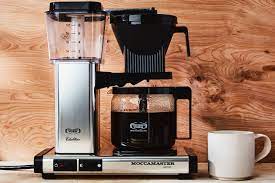
How Does An Auto-Drip Coffee Maker
The water gets pumped from the reservoir and to the heating element which then does what the heating elements do and heats your water. It also provides heat for the hot plate.
As your water begins to heat and comes to a boil, air bubbles are created which causes the all too familiar gurgling sound. The bubbles then rise up through the tube and drip over your coffee grounds.
Modern drip coffee makers are very well-designed with no need at all to be concerned about an uneven distribution of water over the coffee grounds as they spray in an even fashion over the coffee grounds.
(depending on which model).
The hot water then passes through the coffee grounds and through the coffee filter and into the carafe at the bottom.
Slowly your coffee pot will fill, at which point your coffee is ready. Simply add sugar and milk as per your own requirements.
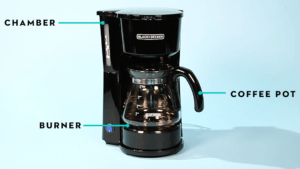
Pour Over Coffee Vs Drip Coffee – The Final Drink Quality
Naturally speaking, the “quality” is entirely subjective and based on an opinion. How you like your coffee and how another person does can be entirely different. I love a good medium roast and at times a really good darker than dark roast.
It does depend on what kind of coffee drink and brewing method I have them with.
This is one of the huge bonuses of pour over coffee brewing, it permits the use of any roast levels really, although I recommend a medium to dark roast that is only a personal preference.
It is a 100% manual process of brewing that you can adjust and customize to get the perfect brew for all types of roast.
It is a coffee brewing method that requires skill, attention to detail and patience. It is easy to master and, to truly master pour over, it is best done with quality equipment to get the perfect pour and extraction.
With that said, it is also possible to get it all wrong and make a terrible cup of coffee. This is why practice is needed and the determination to stick with it. The reward of making an amazing cup of pour over coffee every single time is worth it.
Pro Tip: Take notes and keep a record of all the variables for the coffee beans that you used. Roast, grind size, water temperature, bloom time and brew time. Note how it tasted too. This will help you replicate the process and figure out what you can change to make it better if you need to. You will know what to adjust.
Coffee can be a little like science sometimes!
To be fair and to be honest most modern electric drip coffee makers make a quality cup of coffee, and you can use your specialty beans in them if you want to. If you want a full flavored cup of coffee, use a metal filter rather than a paper filter.
The one bonus that you have when it comes to drip machines is consistency – you will get the same cup of coffee every single time and effortlessly.
The downside is that you cannot and will not be able to personalize and tailor the coffee to exactly what you want.
Although I am saying here that pour over brewing produces a better quality cup of coffee, it takes practice and patience. I’m not dismissing drip coffee out of hand as you do get a great cup of coffee and with almost no effort, you just cannot customize to your own personal taste that is all.
Amount Of Control Over The Brewing Process – Drip Coffee Vs Pour Over!
This is something I have drilled in already and, which one is best here is also subjective and depends on what you personally want.
Do you want full control or very little and mostly automated process?
With the pour-over method you have a lot more control, literally full control over all the variables that will affect the outcome of your coffee.
- Water temperature.
- Brew time.
- The bloom.
- Flow of water over the coffee grounds.
- Grind size and quality.
- Type of filter used.
- Coffee to water ratio (also known as the ratio of grounds to water).
With electric drip coffee machines you only have control over some of the variables listed above, namely the type of coffee filter, grind size and quality and the coffee to water ratio (although this is mostly an automated thing). The rest you have no control over at all.
How Do These Variables And The Level Of Control Affect Your Coffee?
To get a good understanding of how important it is to have control over the variables, let’s talk about them in more detail.
Water Temperature
If you don’t have the right equipment the water temperature is difficult to control as the the perfect brewing temperature is a very small window of 4 degrees celsius (10F). 92C (195F) and 96C (205F).
Either side of this temperature range, and you will get a slightly or increasingly sour coffee, when below 92C (195C) or overtly bitter when brewing above 96C (205F).
The use of a digital thermometer will help you a lot to check and measure that your water is within this range. This is also where the big advantage of having a digital temperature controlled gooseneck kettle helps a lot.
Coffee To Water Ratio
This one should be a lot more obvious than the subtle effect that water temperature has. The more coffee grounds you use, the more focused the coffee to water ratio is and the stronger and fuller flavor you will have.
Conversely,
for a lighter flavor, use less grounds (or more water) and the higher and less focused the ratio of coffee to water ratios, and the weaker and lighter your coffee will be.
Flow Rate (Pour Speed)
This is related to the amount of time that the water is in contact with the coffee grounds. If the flow, your pour speed is too fast, there will be a reduced contact between the coffee grounds and the water, the result will be a weak tasting cup of coffee.
The opposite is also true.
If the flow rate is too slow, the water will be in contact with the grounds for longer and will be stronger.
The key is to strike a balance. This is where the skill factor, experience and concentration help you with your pour over. It is also here where a gooseneck kettle is invaluable and priceless.
Of course, with a drip machine this is automated.
Grind Size And Grind Consistency
The grind size and the importance of a good, even and consistent grind size is important as an uneven grind size will result in an uneven extraction. Different sizes will end up extracting at different rates, this is not good. Use a quality ceramic burr grinder to get an even grind size.
Using the correct grind size, this follows on from the flow rate. If your grind size is too large, you will get a poor level of contact with the water and the water will run through grounds easier, and you will get a weaker cup of coffee.
When your grind size is too small, your water will not flow through your coffee grounds so easily and will over extract resulting in a strong, bitter coffee.
That is how important grind size and water flow is.
Type Of Filter
The type of filter used will result in a different tasting coffee – for all brewing techniques. While a paper filter is the popular option, many coffee lovers don’t think about or consider the effect that it has on the delicious coffee that you are trying to brew.
A paper filter will filter out all the coffee oils and result in a very light tasting and clean, crisp coffee.
A metal filter will result in a coffee that is fuller in flavor and a fuller body due to not filtering out any of the coffee oils.
A cloth filter will remove only some coffee oils and produce a middle of the road coffee that is a middle ground between a paper filter and a metal filter.
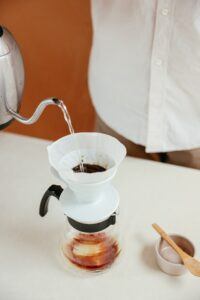
Pour Over Coffee Vs Drip Coffee: Brew Time
The brewing process for both drip coffee and pour over coffee takes more or less the same amount of time to produce a cup of coffee of the same size.
Over all, the drip brewing process is quicker due to a reduced preparation time required for drip coffee machines.
Grind the beans, add the filter to the basket, fill it with grounds, then fill the water reservoir and then press the brew button and wait.
The pour-over coffee brewing technique is much more complex and requires a longer preparation time.
On top of the grinding of the beans and preparing the filter you need to heat the water, pour it, slowly and consistently often re-heating the water to ensure the temperature remains within the preferred ideal temperature, keeping an eye on the flow rate, not too fast, not too slow…
It is a popular option, but you need to consider the total time it takes. Definitely not a brewing method to use when you are in a rush.
Pour Over Coffee Ratio Vs Drip Coffee Ratio
It is tight!
There is not much in the two different styles of making coffee here as they are very similar. What is very important is that you use the correct coffee to water ratio for each one.
For the pour over ratio of coffee to water it is 1:15, with one part of coffee and 15 parts water. With drip coffee the ratio is 1:16.
Drip Vs Pour Over Grind Size
Again these two very different types of coffee draw similarities here when it comes to the grind size, a very important aspect of coffee brewing, as I mentioned earlier.
For pour over coffee you have a little play room, you can use a medium to coarse grind size or a medium-coarse grind size. The ability to have a slight difference here is down to the fact that you can adjust other variables to compensate for the slightly larger (or slightly smaller) grind size.
A drip coffee maker does not, unfortunately, give you any room for variance as you must use a medium grind size. It is important that you read the owners manual to double-check. They may recommend a slightly different size, like a medium-coarse.
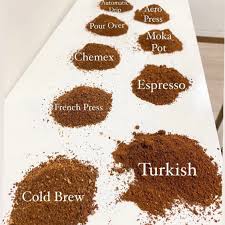
The Ideal Roast Profile
With Pour over coffee medium to medium-dark roasted coffee works best and makes great coffee. This is only based on my opinion and my coffee-loving experience.
You can of course make a fabulous light roast or blonde roast with using the pour over brewing technique and is particularly great when you are using specialty grade single origin coffee beans as you can really draw out all the unique flavors of the origin.
You are really free to use any roast profile that you so wish.
With a drip coffee maker you can, at least technically, use any roast profile but the result with even the best of light roasts is just not there. It is just too light tasting and does not draw out the flavors as well as it does with medium and medium dark profiles.
Unfortunately, there is nothing you can do about it; you can’t adjust your machine in any way at all to compensate and make a better cup of coffee with a light roast. You are simply stuck with two roast profiles to choose from: Medium or medium-dark.
The Taste Challenge
Drip coffee unfortunately gets a poor repetition and unfairly labelled as an old-fashioned coffee or a coffee of low quality.
Sure,
it is a simple and very smooth, often very clean and crisp tasting coffee. This can be altered slightly by switching out a paper filter and using a cloth or metal filter instead.
The biggest drawback is unfortunately one of the better selling points – the hot plate that keeps the coffee warm. When you use this and leave your coffee sitting too long, your beverage becomes stewed and not at all pleasant tasting.
The solution is not to use it and use a thermal coffee pot to keep your coffee warm.
It is true that modern drip machines are much better, have more advanced and appealing features that help them to brew a much better cup of coffee.
Pour over coffee brewing is the brewing method and choice for coffee nerds and geeks. There is a reason why. They, coffee geeks, know a lot about coffee and coffee brewing. It is a passion of theirs, a hobby they enjoy.
Pour over is simply fantastic at drawing out the unique characteristics and nuances from high quality coffee beans. With this technique you are able to draw out the subtle flavors and tastes and light hints that other methods cannot.
The flavor can still be clean and crisp, if that is what you wish – use a paper filter. If you want a bolder flavor and bold taste, use a metal filter with your pour over.
The clear winner of the two brewing methods is which one produces the best tasting coffee and that is hand down the pour over method.

Benefits Of Pour Over Coffee
Pour over coffee is a popular choice for coffee geeks and coffee nerds as it accentuates all the delicate and intricate flavors from the coffee grounds, something that few coffee brewing techniques can do.
It is good clean coffee, consistently brewed with a fresh flow of water which allows for a very clean extraction of the fragrances, oils and flavor compounds.
Benefits Of Drip Coffee
The stand-out benefit of drip coffee is the ease of preparation and the ability to get factory-like consistency in terms of flavor and taste in every cup with no effort on your part.
Like pour over coffee, it produces a good clean cup of coffee due to the flow of fresh, clean hot water while brewing – which when compared to an immersion technique like the French press, which produces a great cup of coffee too, but is missing the clean fresh taste that drip and pour-over brewing produce due to that flow of clean water.
Also, with drip coffee you can make large batches of coffee easily.
Frequently Asked Questions About Pour Over Coffee Vs Drip Coffee
Is Pour-Over Coffee Considered Drip Coffee?
Even though pour-over coffee is a very special form of manual drip brewing method it is not considered as drip coffee. It is important to differentiate between the two as the results are different and more personalized for the coffee drinker or the barista.
With pour-over coffee you have full control over the process and end result, including the hot water temperature and flow rate. With a drip coffee maker you have little control over the process other than the type of coffee grounds and the grind size.
Is Pour Over Or Drip Coffee Better?
Yes, in my opinion and that of many coffee experts and coffee lovers is that pour-over coffee produces a better tasting coffee, one that is a more flavorful cup of coffee when compared to regular drip coffee.
Why Does Pour Over Taste Better Than Drip Coffee?
A pour over coffee tastes better due to the differences in the two brewing processes. A drip coffee tends to have a litter faster brewing time, meaning there is a reduced contact time with the coffee grounds and less time to extract the flavors from the coffee grounds.
Pour over coffee is a slower brewing process meaning your hot water is in contact with your coffee grounds for longer which gives it more time to extract the flavors and oils, the result of which is a better tasting coffee.
Does Pour Over Have More Caffeine?
Pour-over coffee and drip coffee more or less have the same amount of caffeine for all drink sizes when comparing on an “apples with apples” basis. When you start to use or compare with different coffee beans, different roast and Arabica for one and Robusta for the other, you will get skewered results.
Measuring on a scientific basis with all variables the same, a pour-over coffee has more or less the same amount of caffeine.
Here is a table for comparison of pour over coffee Vs drip coffee caffeine content for 3 popular drink sizes.
| Drink Size | Drip Coffee Caffeine Content | Pour Over Caffeine Content |
| 8 Oz (240 ml) | 95 mg. | 90 mg. |
| 12 Oz (360 ml) | 140 mg. | 135 mg. |
| 16 Oz (480 ml) | 190 mg. | 185 mg. |
How Do You Make Drip Coffee Taste Better?
There are a few things that you can do to make your drip coffee taste a lot better. Make the first step to clean your electric drip coffee maker and ensure the pipes are cleaned too and clean it regularly.
You can buy freshly roasted whole beans and grind them yourself is another step you can take.
Consider the use of a better quality of water, filter water or filtered water. When your coffee is ready, take your carafe away from the heat source to stop it from stewing.
Why Is My Pour Over Coffee Weak?
The most likely and most common cause of weak and under brewed coffee is the wrong grind size. It is likely that your grind is too large, which means the water is not in contact with the coffee grounds for long enough to extract the flavor compounds or oils, which results in an under extracted, under brewed coffee.
Is Pour-Over Coffee Better Than Drip?
Yes, in my opinion and experience, pour over coffee is better than drip coffee for yoru specialty grade light roast coffee and medium roast coffee beans. The brewing technique of a constant flow of hot water over freshly ground coffee gets more total dissolved solids into your brew and as a result you get a tastier cup of coffee.
Why Is Pour-Over Coffee So Much Better?
Pour over coffee is so much better due to its ability to extract more of the nuance flavors and get the delicate and intricate flavors into your cup of coffee.
Final Thoughts – Pour Over Coffee Vs Drip Coffee
Well, since you have read this far you know everything that you need to know about pour over coffee Vs drip coffee and which is most suitable for you and when.
If you are a real coffee lover looking to get the best out of your beans then, honestly, it will be worth your time in taking the effort to really master pour over coffee brewing. It will also be more than worth it to use a digital temperature-controlled gooseneck kettle.
If you want a good, clean tasting coffee without all the preparation fuss, a drip coffee will be better for you. Take your time to know the machine and read the instruction manual to know the exact settings and what you can adjust to make your coffee slightly better.
Which is your own preference – who wins this battle of the brew for you? Pour over or drip coffee?
Join our online coffee community on Facebook/Meta and let us know!

